🚖 Tesla: Into The Unknown
Autonomy's timeline remains clear as mud
Welcome to the Free edition of How They Make Money.
Over 200,000 subscribers turn to us for business and investment insights.
In case you missed it:
Tesla’s Q3 headline looks impressive with 497K deliveries, a sharp rebound that shows the EV pioneer can still move units.
But much of that strength likely came from a last-minute rush before the $7,500 US tax credit expired, raising doubts about underlying demand. Outside the US, Tesla’s market share kept slipping.
Tesla remains all about the road ahead—specifically, autonomy.
Projects like the humanoid robot Optimus and Musk’s Robotaxi ambitions still dominate the narrative, even if the timeline to real revenue is as murky as ever.
Let’s break it down.
Today at a glance:
Tesla Q3 FY25.
Latest developments.
Key quotes from the earnings call.
What to watch for autonomy.
1. Tesla Q3 FY25
Tesla’s business still revolves around three pillars:
🚗 Automotive: Revenue from selling EVs (75% of revenue). Deliveries rose 7% Y/Y to 497K vehicles, while production fell 5% to 410K, suggesting Tesla is tapping into existing inventory amid uneven demand.
🌞 Energy Generation and Storage: Revenue from solar products and energy storage solutions, like Solar Roof and Powerwall (12% of revenue).
🔌 Services and Other: Revenue from vehicle service, Supercharger network, and sales of auto parts and accessories (12% of revenue).
Income statement:
Revenue +12% Y/Y to $28.1 billion ($1.4 billion beat).
Gross margin 18% (-2pp Y/Y).
Operating margin 6% (-5pp Y/Y).
Non-GAAP EPS $0.50 ($0.06 miss).
Segment performance tells the real story. The non-auto segments were up 33%, driving most of the growth. They represented 28% of Tesla’s gross profit.
Gross margin trends:
Auto: 15% (excluding credits), stable after dropping to 12.5% in Q1.
Energy: 31%, the highest margin segment improving again.
Services and Other: 11%, the 14th consecutive profitable quarter.
Tesla’s historically strong margins have been supported by gigafactory scale, direct-to-consumer sales, and minimal marketing costs. But those advantages are being eroded by price cuts and rising competition. In the past three years, the auto gross margin has worsened and is merely in line with BYD today.
Cash flow:
Operating cash flow: $6.2 billion, flat Y/Y (trailing revenue growth).
Free cash flow: $4.0 billion, surging +46% Y/Y, due to lower Capex, declining 36% Y/Y (and 6% Q/Q) to $2.2 billion. Tesla expects spending to drop to just $9 billion in FY25 — a two-year low.
Guidance:
FY25 outlook: Tesla again withheld full-year guidance, citing trade and fiscal policies. They previously admitted to potential political backlash from Musk’s public stances. Despite the Q3 rebound, a return to growth (predicted earlier this year) remains unlikely, especially if Q3 demand was front-loaded in the US. Remember: Musk predicted 20–30% growth for FY25 late last year. So far, revenue declined 3% Y/Y in the first nine months.
So, what to make of all this?
💸 Bottom-line erosion: Operating income rebounded from Q2 but was still 40% down Y/Y as operating expenses surged 50% to $3.4 billion, including the impact from stock-based compensation and restructuring charges.
📉 Regulatory credits fading fast: Revenue from Zero-Emission Vehicle sales dropped ~44% Y/Y and is expected to decline further, removing a cushion Tesla has long leaned on.
🔋 Energy & storage scaling but still lumpy: Deployments hit new highs (>12.5 GWh in Q3), but the high-margin boost remains inconsistent and timing-sensitive. Musk teased Megapack 4, which could output at 35 kV and serve directly as substation infrastructure, a timely feature as the global grid becomes the new bottleneck for AI expansion.
📉 Operating margin dropped 5pp Y/Y, reflecting:
🔻 Negative impact: Higher operating expenses, tariff impact ($400 million), AI and other R&D investments, and lower regulatory credits.
🔺 Positive impact: Non-auto segments, delivery rebound.
💰 Balance sheet remains strong: Tesla ended Q3 with ~$36 billion in net cash, giving it ample firepower to fund autonomy and energy projects.
🚗 Ambitious production goal: Musk aspirationally targets an annualized production rate of 3 million vehicles within two years, even as margins compress and EV demand softens. Cybercab would be the main driver.
🧭 Valuation hinges on what’s next: With the core auto business facing tight margins and demand uncertainty for the foreseeable future, Tesla’s valuation depends more than ever on the big bets (Autonomy + Energy) delivering. The timeline keeps shifting—and competitors are not standing still.
2. Latest developments
Here’s a quick rundown of the recent announcements:
🤖 Autonomy build-out remains the narrative: Three months ago, Musk promised “half of the US population” would have robotaxi access in 2025. In the Q3 call, he downgraded to “8–10 cities” by year-end. Optimus V3 could come in early 2026.
🇨🇳 China ramp-up begins amid market pressure: Tesla’s Shanghai Gigafactory is poised to increase output in Q4, and China sales showed a modest uptick (up ~3% Y/Y in September) after months of decline. The broader market, however, remains fiercely competitive from local brands and is weighing on Tesla’s margin and share.
🥊 BYD showdown: BYD’s battery EV deliveries surged 32% Y/Y to 583K, widening its lead over Tesla for the fourth consecutive quarter. While it’s not a perfect comparison (BYD deliveries are not direct-to-consumer), the trend clearly tells a story.
🚙 Cybertruck’s reality check
Tesla sold ~5,400 Cybertrucks in Q3, according to Cox Automotive, a 63% drop Y/Y in a quarter when the expiration of the EV tax credit should have given demand a lift.
In 2023, Musk suggested Tesla could eventually produce 250,000 Cybertrucks a year. The demand reality is proving far more modest so far. Even Ford’s F-150 Lightning (also a full EV) sold over 10,000 units last quarter, and Chevrolet’s Silverado EV nearly doubled sales to just over 3,900 units.
Musk’s ambitious targets are often more aspirational than predictive, and investors should focus on execution and demand signals rather than headline promises.
✉️ Shareholder Deck Update
🌍 Market share: After years of expansion, Tesla is steadily declining across all regions. The visual in Tesla’s deck shows a worrisome trailing 12-month view. The US/Canada rebound is likely a “mirage” from the EV tax credit deadline pulling demand forward.
🤖 FSD: Tesla’s fleet has now logged 6 billion miles using FSD (Supervised), strengthening the data-advantage thesis. That said, true unsupervised deployment remains elusive, and generating revenue from it is still a way off. So, the promise stays intact, but the clock keeps ticking.
3. Key quotes from the earnings call
Check out the earnings call transcript on Fiscal.ai here.
Elon Musk on going driverless and expansion:
“Within a few months, we expect to have no safety drivers at all at least in parts of Austin […] We do expect to be operating Robotaxi in about 8 to 10 metro areas by the end of the year. It depends on various regulatory approvals.”
Big promise, familiar caveats. State-by-state rules and local permits will govern pace. Even Tesla says it will start new markets with a safety driver for several months. Treat timelines as aspirational. We could be years away from a paid, driverless service at scale.
On FSD v14:
“The first priority when we release a major new Autopilot architecture is safety. […] By 14.2, we will have addressed many of the comfort issues. […] This car is going to feel like it is a living creature.”
Version 14 is Tesla’s biggest step toward end-to-end autonomy that handles perception, planning, and control in one stack. Early testers describe a smoother experience, but not fully hands-free autonomy. Musk’s “living creature” comment hints at the new reasoning layer, with cars learning to drop you off, park, and adapt in real time. It’s a major architectural leap, though still miles from true robotaxi independence.
Musk’s tone has clearly shifted, from defensive earlier this year to outright conviction that unsupervised autonomy is “100% solvable.” That confidence, more than the data, fueled optimism on the call.
VP of AI Ashok Elluswamy on scale and milestones:
“We continue to operate our fleet in Austin without anyone in the driver’s seat […] In the Bay Area, where we still have a person in the driver seat because of the regulations […] we cross more than a million miles. […] Customers have used Full Self-Driving supervised for a total of 6 billion miles as of yesterday.”
The data advantage is real and compounding. But the cars are still supervised remotely (like Waymo in its early days). Until “unsupervised” is approved and insured broadly, FSD remains a powerful feature—not a standalone revenue engine.
CFO Vaibhav Taneja on robotaxi adoption and costs:
“The total paid FSD customer base is still small, around 12% of our current fleet […] Robotaxi costs are included within Services and Other.“
Monetization remains early (only ~1 in 8 owners paying for FSD). This accounting note matters: Robotaxi burn isn’t in the auto gross margin. It sits in Services—important when comparing segment profitability.
Musk on the AI5 chip and dual foundry plan:
“We’re going to focus both TSMC and Samsung initially on AI5 […] By some metrics, the AI5 chip will be 40× better than AI4 […] I think AI5 will be the best performance per watt, maybe by a factor of 2 or 3 and the best performance per dollar for AI, maybe by a factor of 10.”
These are massive claims. Dual-sourcing de-risks supply, but execution risk is high: new design, new nodes, and a CapEx ramp for 2026 and beyond. The proof won’t come from specs, but from shipped silicon and real-world performance.
On Optimus timelines:
“We look forward to unveiling Optimus V3 probably in Q1 […] we’re going to be building a 1 million unit Optimus production line hopefully, with the production start towards the end of next year. […] Ultimately, we’ll do Optimus 4, that will be 10 million units. Optimus 5, maybe 50 million to 100 million units.”
Ambition dial at 11. Treat volumes as a goal post (see Cybertruck reality above). Near-term value driver remains software and vehicles, with Optimus as optionality.
4. What to watch for autonomy
🚖 Robotaxi’s reality check
Driver-out, not driverless: Tesla now operates a small robotaxi fleet in Austin with no one in the driver’s seat, a symbolic step forward. Still, vehicles remain geofenced and remotely supervised, far from true Level 5 autonomy. Regulatory clearance continues to gate expansion to the Bay Area and other markets.
FSD v14 rollout: Version 14 introduced Tesla’s largest neural-network rewrite yet — improving safety, comfort, and “reasoning” (like dropping riders off, finding parking, or adapting routes). Still supervised, with early testers noting erratic corner cases. The path to a paid, nationwide ride-hailing network remains uncertain.
Competitive pressure mounts: Waymo remains ahead on regulatory and safety validation, operating fully driverless rides in multiple US cities. Meanwhile, Tesla faces ongoing NHTSA scrutiny after reports of traffic violations during early robotaxi testing.
Why it matters: Autonomy remains Tesla’s trillion-dollar story, but execution risk looms large. For context, Uber, with 170 million monthly users and nearly half of global ride-hailing, is worth $200 billion — proof that scale alone doesn’t guarantee multi-trillion-dollar upside (as predicted by Musk), however bold the vision.
🤖 The Optimus ambition
Next-gen prototype coming: Musk said Optimus V3 could be shown in Q1 2026, with a production-intent line targeting 1 million units per year. He called it “the biggest product of all time.”
AI crossover: Tesla now trains Optimus with the same vision-only real-world AI used in FSD, replacing motion-capture inputs. It’s an elegant engineering bridge, but still a long way from commercial utility.
Execution challenges: Hand dexterity, supply-chain depth, and manufacturing complexity continue to be limiting factors. Musk admitted that the hand and forearm are harder to engineer than the rest of the robot.
Why it matters: Optimus could redefine Tesla’s scope beyond vehicles, from mobility to labor itself. But as with robotaxi, the gap between demo and delivery remains wide.
Musk insists Tesla is no longer just a carmaker but an AI and robotics company.
Yet Tesla doesn’t operate in a vacuum. Virtually all of Big Tech is chasing the same frontier — from autonomous mobility (Waymo, Zoox, Uber) to embodied AI (Amazon’s Vulcan, Figure AI, 1X, Agility Robotics). The vision is bold, but the timeline is uncertain, and execution risk remains high. Reframing the mission doesn’t change the fact that Tesla is not playing a single-player game.
That’s it for today!
Stay healthy and invest on.
Want to sponsor this newsletter? Get in touch here.
Thanks to Fiscal.ai for being our official data partner. Create your own charts and pull key metrics from 50,000+ companies directly on Fiscal.ai. Start an account for free and save 15% on paid plans with this link.
Author's Note (Bertrand here 👋🏼): The views and opinions expressed in this newsletter are solely my own and should not be considered financial advice or any other organization's views.
Disclosure: I am long TSLA, GOOG, NVDA, and UBER in the App Economy Portfolio. I share my ratings (BUY, SELL, or HOLD) with App Economy Portfolio members.



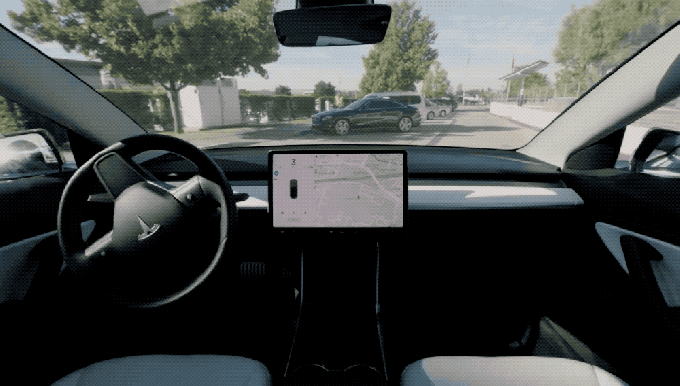
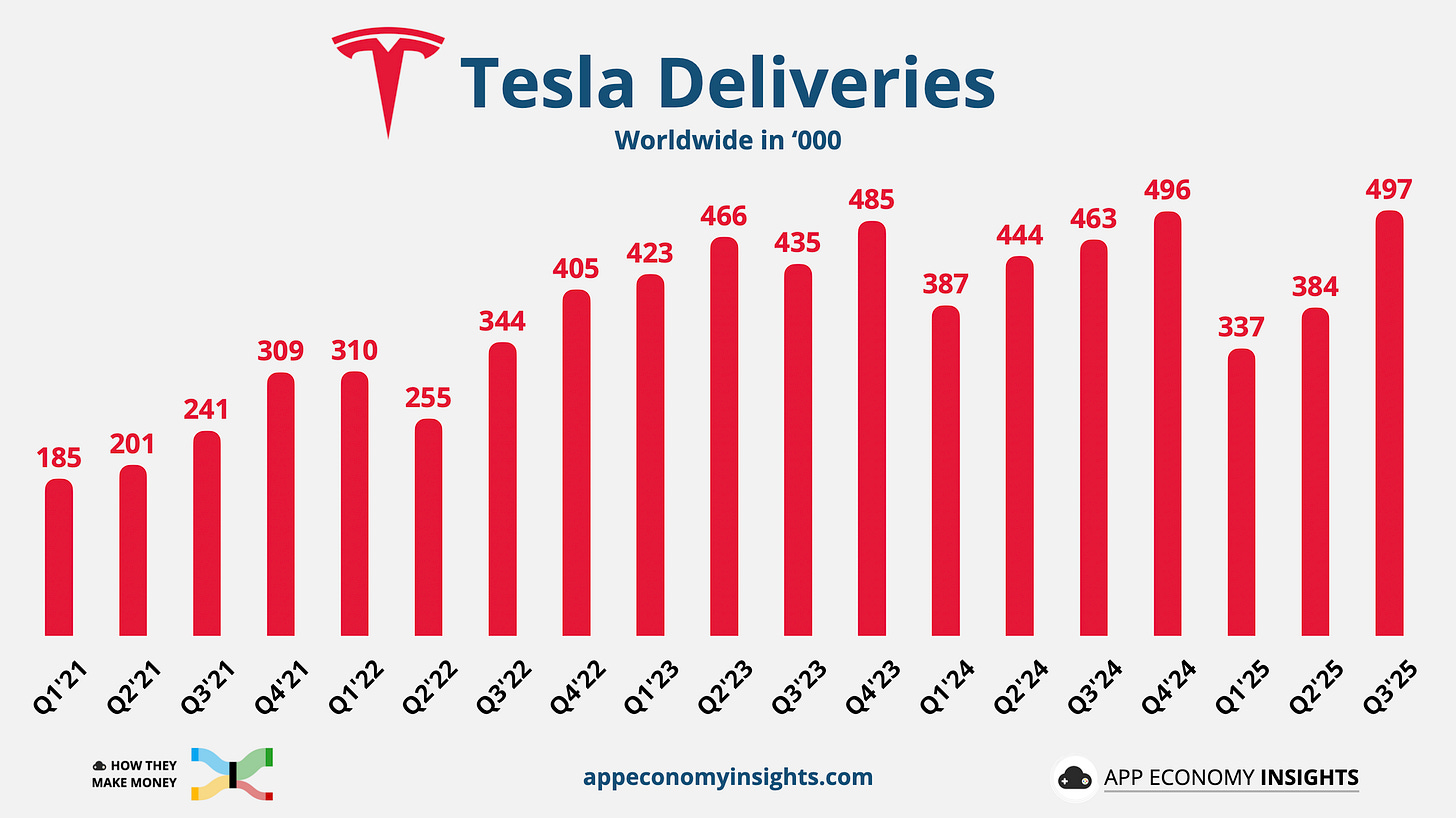

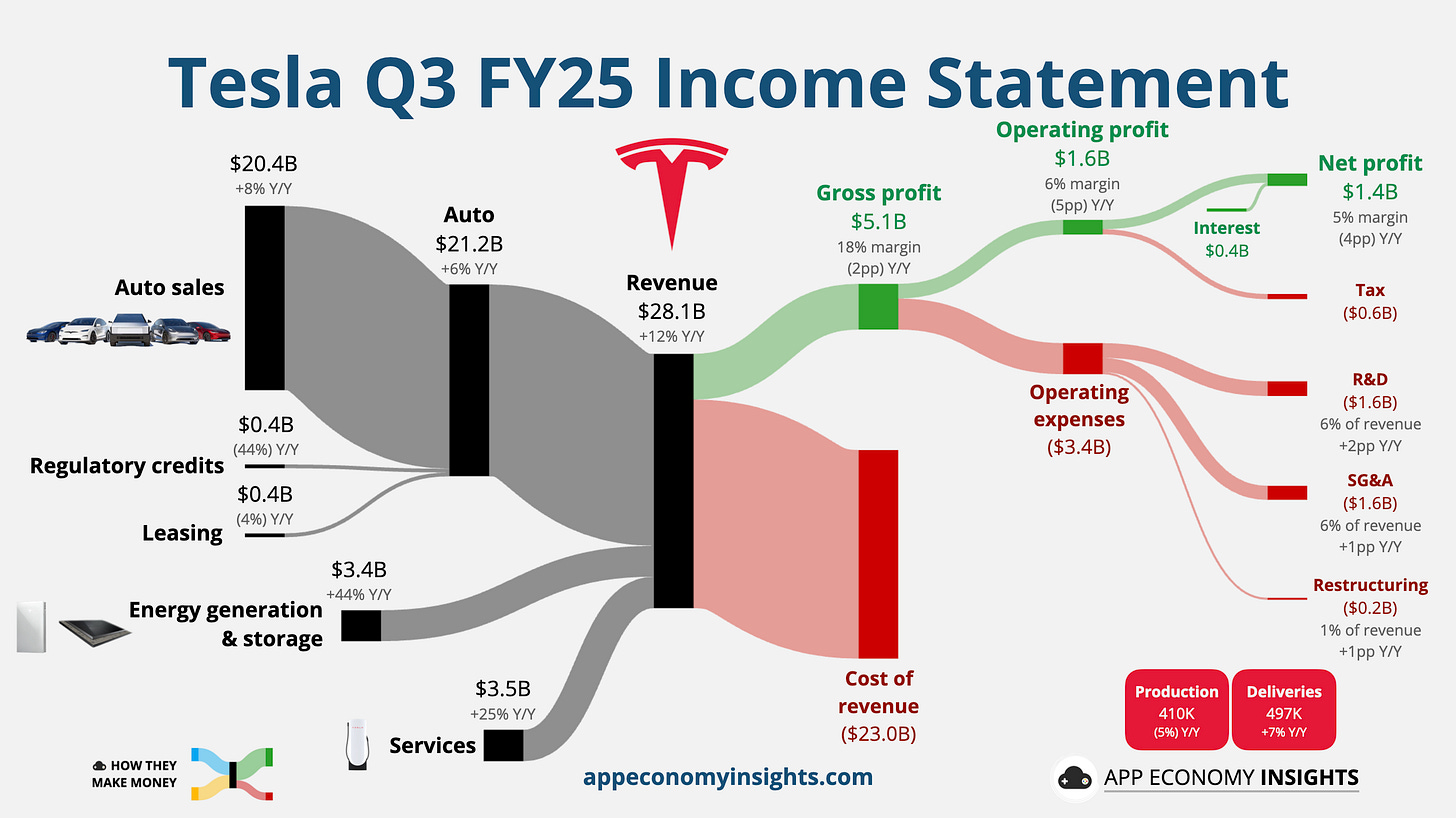
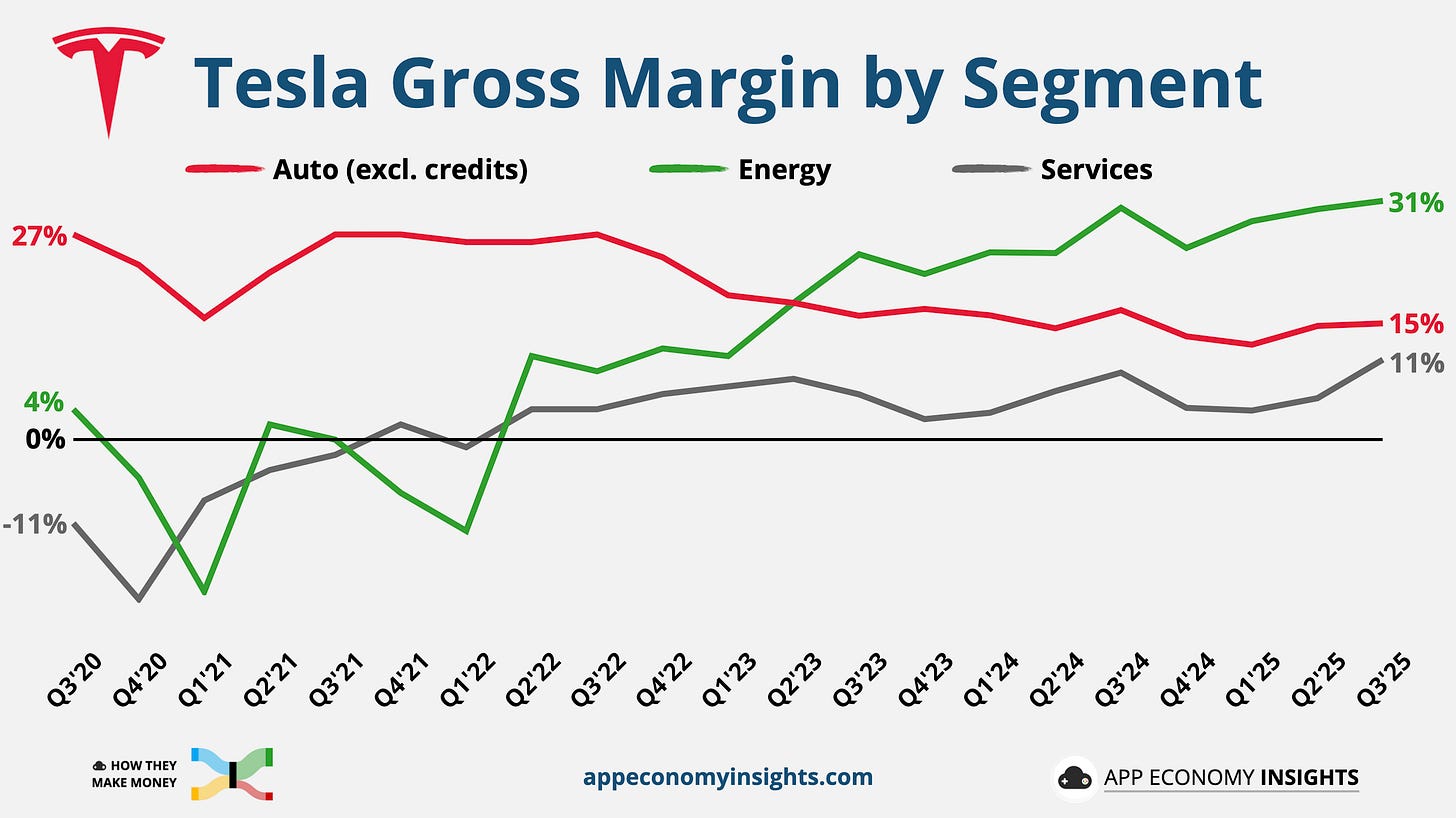
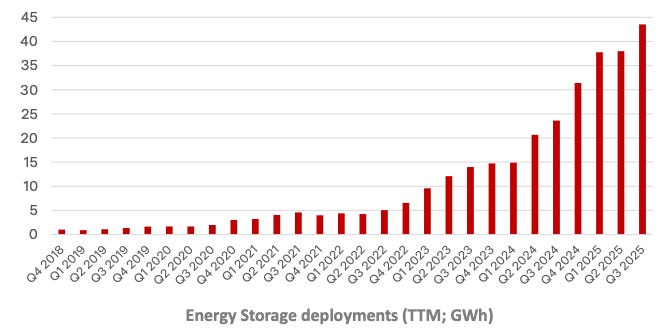
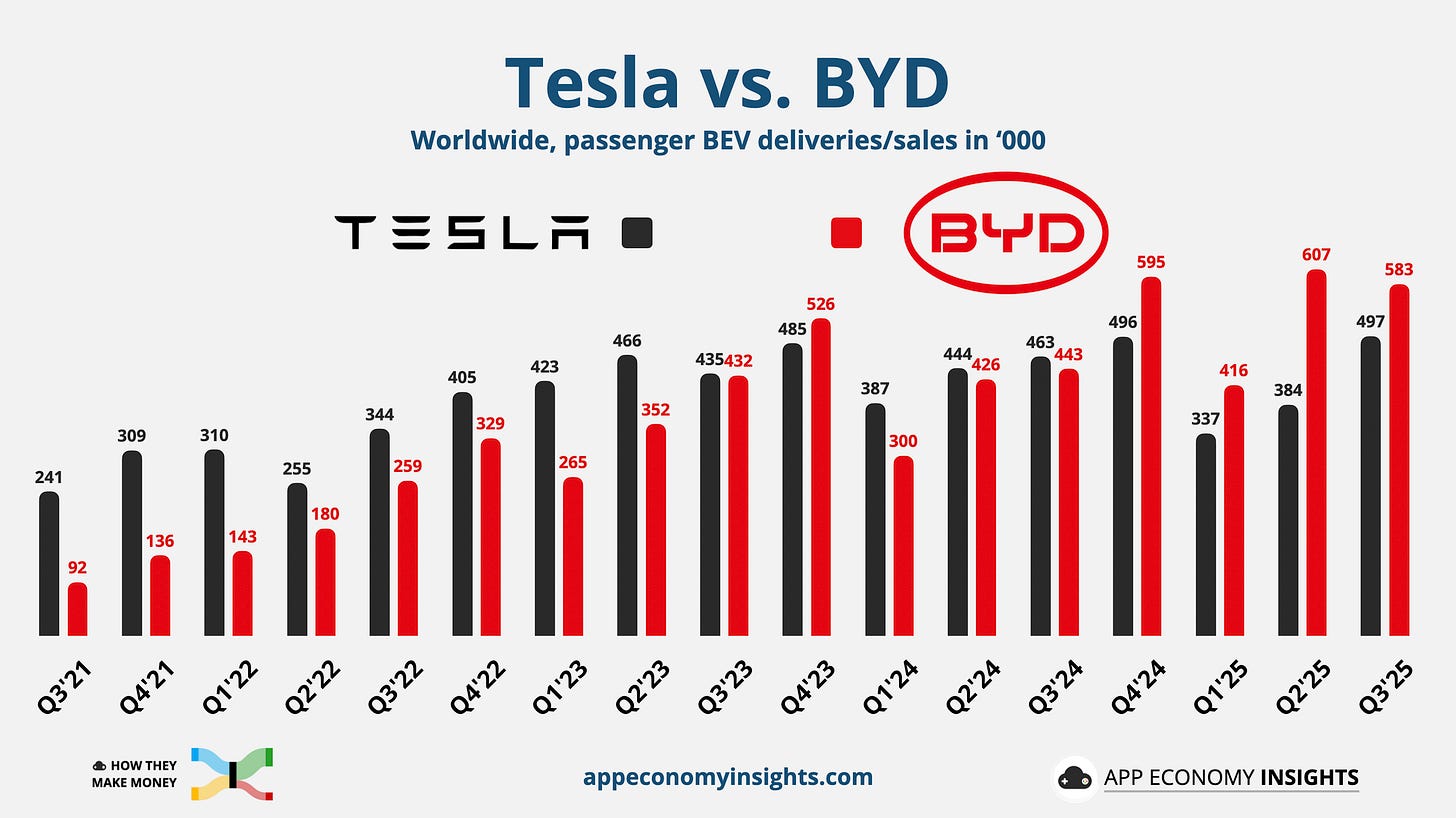
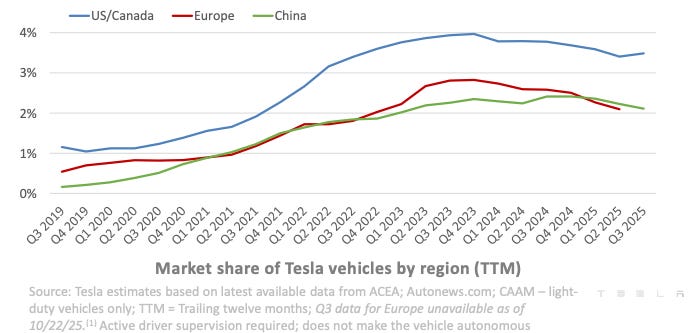
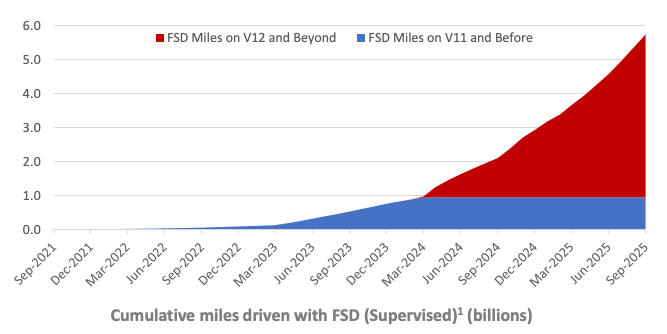
The dreams you can sell are worth more than money.
The Cybertruck production ramp is definitely a cautionary tale - going from 250k projections to 5.4k in Q3 shows the manufacturing complexity. But I think the bigger story here is the dual foundry strategy for AI5. Having both TSMC and Samsung lined up reduces single-point failure risk and could accelrate deployment across the fleet. The 6B FSD miles data set is still the largest in the industry, which should give them an edge on edge cases and safety validation when regulators finally do grant approvals.